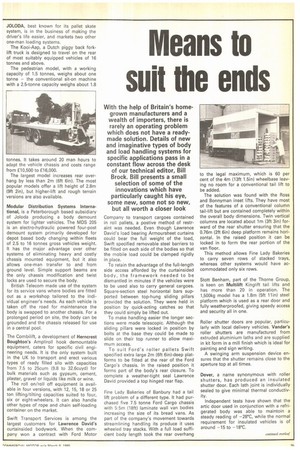eans to suit the ends
Page 37

If you've noticed an error in this article please click here to report it so we can fix it.
JOLODA, best known for its pallet skate system, is in the business of making the driver's life easier, and markets two other one-man loading systems.
The Kooi-Aap, a Dutch piggy back forklift truck is designed to travel on the rear of most suitably equipped vehicles of 16 tonnes and above.
The pedestrian model, with a working capacity of 1.5 tonnes, weighs about one tonne the conventional sit-on machine with a 2.5-tonne capacity weighs about 1.8 tonnes. It takes around 20 man hours to adapt the vehicle chassis and costs range from £10,500 to £16,000.
The largest model increases rear overhang by less than 2m (6ft 6in). The most popular models offer a lift height of 2.8m (9ft 2in), but higher-lift and rough terrain versions are also available.
Modular Distribution Systems International, is a Peterborough based subsidiary of Joloda producing a body demount system for lighter vehicles. The MDS 205 is an electro-hydraulic powered four-post demount system primarily developed for depot based body changing within fleets of 2.5 to 16 tonnes gross vehicles weight. It has the major advantage over other systems of eliminating heavy and costly chassis mounted equipment, but it also allows one-man transfer to and from ground level. Simple support beams are the only chassis modification and twist locks are used to secure the body.
British Telecom made use of the system for its service vans where bodies are fitted out as a workshop tailored to the individual engineer's needs. As each vehicle is taken off the road for maintenance the body is swapped to another chassis. For a prolonged period on site, the body can be grounded and the chassis released for use in a central pool.
The Combilift, a development of Herncrest Boughton's Ampliroll hook demountable equipment, caters for specific civil engineering needs. It is the only system built in the UK to transport and erect various types of ready filled silo with capacities from 7.5 to 25cum (9.8 to 32.6cuyd) for bulk materials such as gypsum, cement, plaster, gravel or liquids like milk or wine.
The roll on/roll off equipment is available in four versions, with 12, 15, 18 or 25 ton lifting/tilting capacities suited to four, six or eight-wheelers. It can also handle other types of rope and chain self-loading container on the market.
Swift Transport Services is among the largest customers for Lawrence David's curtainsided bodywork. When the company won a contract with Ford Motor
Company to transport cargoes contained in roll pallets, a postive method of restraint was needed. Even though Lawrence David's load bearing Armoursheet curtains could bear the full weight of the load, Swift specified removable steel barriers to be fitted on each side of the bodies so that the mobile load could be clamped rigidly in place.
To retain the advantage of the full-length side access afforded by the curtainsided body, the framework needed to be dismantled in minutes if the vehicles were to be used also to carry general cargoes. Square-section steel horizontal bars supported between top-hung sliding pillars provided the solution. They were held in position by quick-acting catches so that they could simply be lifted out.
To make handling easier the longer sections were made telescopic. Although the sliding pillars were locked in position by bolts at the base they could be made to slide on their top runner to allow maximum access.
To suit Ford's roller pallets Swift specified extra large 2m (6ft 6in)-deep platforms to be fitted at the rear of the Ford Cargo's chassis. In the raised position it forms part of the body's rear closure. To complete a weather-tight seal Lawrence David provided a top hinged rear flap.
Fine Lady Bakeries of Banbury had a tail lift problem of a different type. It had purchased five 7.5 tonne Ford Cargo chassis with 5.5m (18ft) laminate wall van bodies increasing the size of its bread vans. As part of the company's movement towards streamlining handling its produce it uses wheeled tray stacks. With a full load sufficient body length took the rear overhang
to the legal maximum, which is 60 per cent of the 4m (13ft 1.5in) wheelbase leaving no room for a conventional tail lift to be added.
The solution was found with the Ross and Bonnyman inset lifts. They have most of the features of a conventional column tail-lift but are contained completely within the overall body dimensions. Twin vertical columns are located about lm (3ft 3in) forward of the rear shutter ensuring that the 0.76m (2ft 6in) deep platform remains horizontal. In the raised position it can be locked in to form the rear portion of the van floor.
This method allows Fine Lady Bakeries to carry seven rows of stacked trays, whereas other systems would have accommodated only six rows.
Stott Benham, part of the Thorne Group, is keen on Multilift Kinglift tail lifts and has more than 20 in operation. The 1,500kg model has a 1.8m (5ft 1 1 in) steel platform which is used as a rear door and fully weatherproofed, giving speedy access and security all in one.
Roller shutter doors are popular, particularly with local delivery vehicles. Vandar's roller shutters are manufactured from extruded aluminium laths and are supplied in kit form in a mill finish which is ideal for painting and sign writing.
A swinging arm suspension device ensures that the shutter remains close to the aperture top at all times.
Dover, a name synonymous with roller shutters, has produced an insulated shutter door. Each lath joint is individually sealed to give minimal thermal conductivity, Independent tests have shown that the artic door used in conjunction with a refrigerated body was able to maintoin a steady reading of —28°C, while the normal requirement for insulated vehicles is of around —15 to 18aC.
















































































